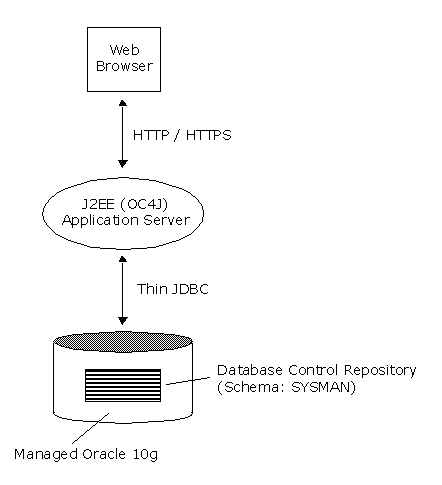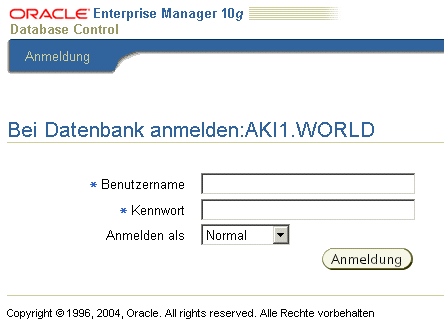Manually configure the Oracle 10g EM dbconsole
Overview
When you choose to create a preconfigured database during the Oracle 10g installation, you can select the Oracle Enterprise Manager (OEM) interface that you want to use to manage the database. The following options are available:
- Database Grid Control
This option is available only if an Oracle Management Agent is installed on the system. When the Installer detects an Oracle Management Agent on the system, it allows you to choose this option and specify the Oracle Management Service that you want to use to manage the database.
If an Oracle Management Agent is not installed, you must choose to use Database Control to manage the database. However, if you install Oracle Management Agent after you install Oracle Database, you can then use Grid Control to manage this database.
- Database Control
This option is selected by default if an Oracle Management Agent is not installed on the system. However, even if a Management Agent is installed, you can still choose to configure Database Control to manage the database.
Custom installation
If you choose the Custom installation type or the Advanced database configuration option during the installation, the Installer does not display the OEM setup screens. Instead, it runs the Database Configuration Assistant (DBCA) in interactive mode, which enables you to create a custom database.
DBCA also enables you to specify the Oracle Enterprise Manager interface that you want to use. Furthermore, you can also use DBCA after the installation to configure Database Control for a database that was not previously configured to use it.
However, if you decide to setup your own Database, you must install the Database Control manually.
Setup your own Database and manually install the Database Control
The Database Control relies on various underlying technologies to discover, monitor, and administer the Oracle Database environment.
From the Database Control, you can monitor and administer a single Oracle Database instance.
The Database Control Framework consists of the Database Control and its underlying technologies:
- A local version of the Oracle Management Service designed to work with the local database or clustered database.
- A local Oracle Management Repository installed in the local database and designed to store management data for the Database Control.
The following steps have to be performed.
Create your own Database
More information to setup your own Database can be found here:
Create the Database Control Repository and setup the OC4J Application Server
Make sure, that you can connect to the Repository Database (Test it with SQL*Plus). Examples for Setup Files can be found here:
Windows
Linux
LISTENER.ORA listener.ora SQLNET.ORA sqlnet.ora TNSNAMES.ORA tnsnames.ora Now start the Oracle EM dbconsole Build Script ($ORACLE_HOME/bin/emca for Linux and $ORACLE_HOME\Bin\emca.bat for Windows).
$ emca -repos create
$ emca -config dbcontrol dbSTARTED EMCA at Fri May 14 10:43:22 MEST 2004
Enter the following information about the database
to be configured.
Listener port number: 1521
Database SID: AKI1
Service name: AKI1.WORLD
Email address for notification: martin dot zahn at akadia dot ch
Email gateway for notification: mailhost
Password for dbsnmp: xxxxxxx
Password for sysman: xxxxxxx
Password for sys: xxxxxxx---------------------------------------------------------
You have specified the following settings
Database ORACLE_HOME: /opt/oracle/product/10.1.0
Enterprise Manager ORACLE_HOME: /opt/oracle/product/10.1.0
Database host name ..........: akira
Listener port number .........: 1521
Database SID .................: AKI1
Service name .................: AKI1
Email address for notification: martin dot zahn at akadia dot ch
Email gateway for notification: mailhost
---------------------------------------------------------
Do you wish to continue? [yes/no]: yes
AM oracle.sysman.emcp.EMConfig updateReposVars
INFO: Updating file ../config/repository.variables ...Now wait about 10 Minutes to complete!
M oracle.sysman.emcp.EMConfig createRepository
INFO: Creating repository ...
M oracle.sysman.emcp.EMConfig perform
INFO: Repository was created successfully
M oracle.sysman.emcp.util.PortQuery findUsedPorts
INFO: Searching services file for used port
AM oracle.sysman.emcp.EMConfig getProperties
...........
...........
INFO: Starting the DBConsole ...
AM oracle.sysman.emcp.EMConfig perform
INFO: DBConsole is started successfully
INFO: >>>>>>>>>>> The Enterprise Manager URL is http://akira:5500/em <<<<<<<<<<<
Enterprise Manager configuration is completed successfully
FINISHED EMCA at Fri May 14 10:55:25 MEST 2004
Try to connect to the database Control
http://akira:5500/em
If you look at the installed schemas, you can now find the SYSMAN schema, which is the database Control Repository.
Troubleshooting
If you have troubles to connect, check your local configuration which can be found in $ORACLE_HOME/<hostname>_<SERVICE_NAME>. For Example our DbConsole Setup Directory looks as follows:
$ pwd
/opt/oracle/product/10.1.0/akira_AKI1/sysman/config
$ ls -l
-rw-r--r-- b64InternetCertificate.txt
-rw-r--r-- emagentlogging.properties
-rw-r--r-- emd.properties
-rw-r--r-- emomsintg.xml
-rw-r--r-- emomslogging.properties
-rw-r--r-- emoms.properties
-rw-r--r-- OUIinventories.addThe most important file is emoms.properties, where you can find all the configuration parameters.
#Fri May 14 10:54:49 CEST 2004
oracle.sysman.emSDK.svlt.ConsoleServerName=
akira_Management_Service
oracle.sysman.eml.mntr.emdRepPwd=0b878f6184e8319d
emdrep.ping.pingCommand=/bin/ping <hostname>
oracle.sysman.eml.mntr.emdRepPort=1521
oracle.sysman.eml.mntr.emdRepDBName=AKI1.WORLD
oracle.sysman.emSDK.svlt.ConsoleMode=standalone
oracle.sysman.emRep.dbConn.statementCacheSize=30
oracle.sysman.db.isqlplusUrl=
http\://akira\:5560/isqlplus/dynamic
oracle.sysman.emSDK.svlt.ConsoleServerPort=5500
oracle.sysman.eml.mntr.emdRepRAC=FALSE
oracle.sysman.emSDK.emd.rt.useMonitoringCred=true
oracle.sysman.eml.mntr.emdRepPwdEncrypted=TRUE
oracle.sysman.db.isqlplusWebDBAUrl=
http\://akira\:5560/isqlplus/dba/dynamic
oracle.sysman.emSDK.svlt.ConsoleServerHost=akira
oracle.sysman.emSDK.svlt.ConsoleServerHTTPSPort=5500
oracle.sysman.eml.mntr.emdRepServer=akira
oracle.sysman.eml.mntr.emdRepSID=AKI1
oracle.sysman.emSDK.sec.ReuseLogonPassword=true
oracle.sysman.eml.mntr.emdRepConnectDescriptor=
(DESCRIPTION\=(ADDRESS_LIST\=
(ADDRESS\=(PROTOCOL\=TCP)(HOST\=akira)(PORT\
=1521)))(CONNECT_DATA\=(SERVICE_NAME\=AKI1)))
oracle.sysman.eml.mntr.emdRepUser=SYSMAN
oracle.sysman.db.adm.conn.statementCacheSize=2
oracle.sysman.db.perf.conn.statementCacheSize=30
Automatically start and stop the DB-Console
$ emctl start dbconsole
$ emctl stop dbconsole
$ emctl status dbconsoleOracle Enterprise Manager 10g Database
Control Release 10.1.0.2.0
Copyright (c) 1996, 2004 Oracle Corporation.
All rights reserved.
http://akira:5500/em/console/aboutApplication
Oracle Enterprise Manager 10g is running.
---------------------------------------------------
Logs are generated in directory
/opt/oracle/product/10.1.0/akira_AKI1/sysman/logHere you can find a start/stop script for the DB-Console for Gentoo Linux.

